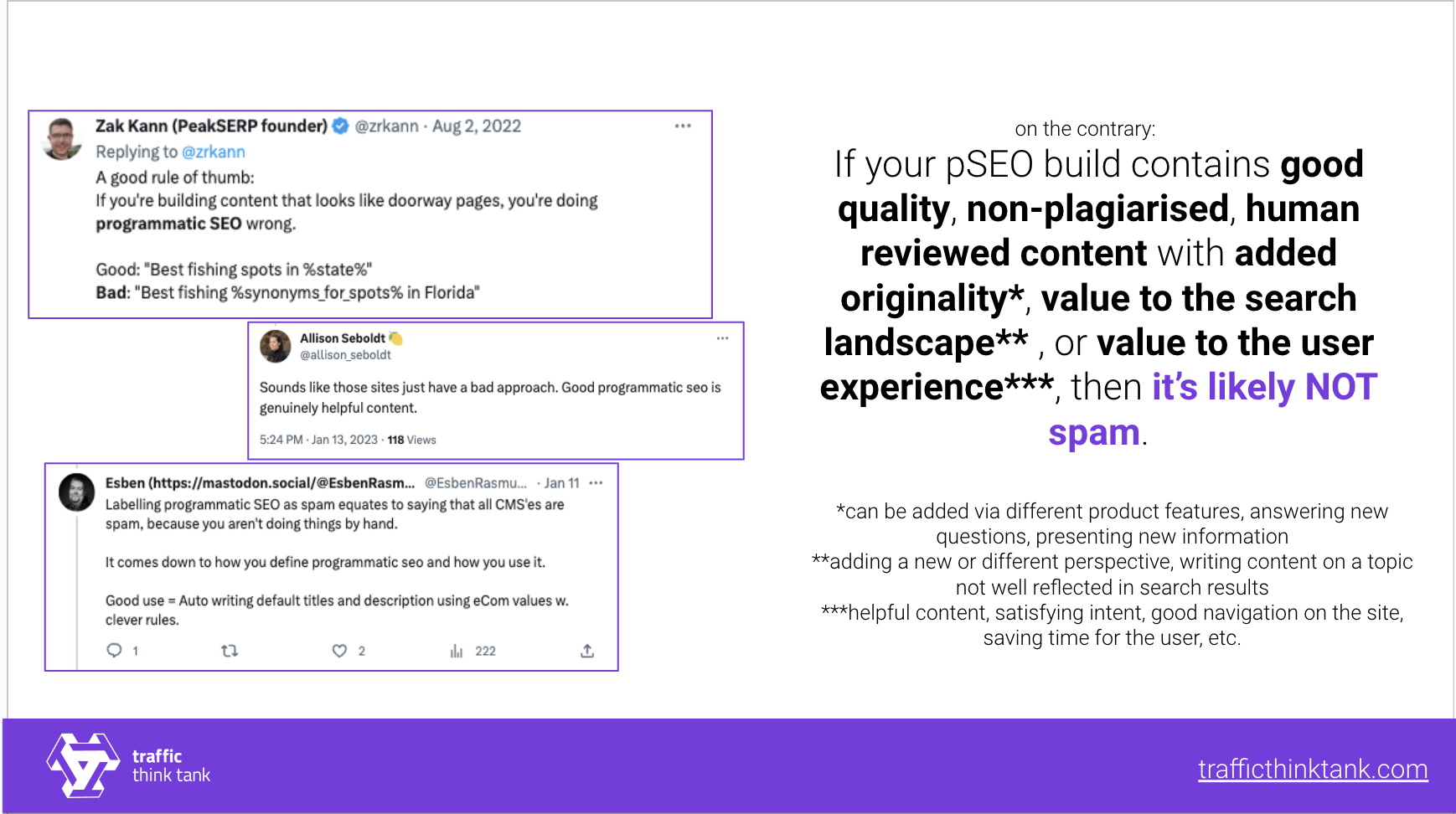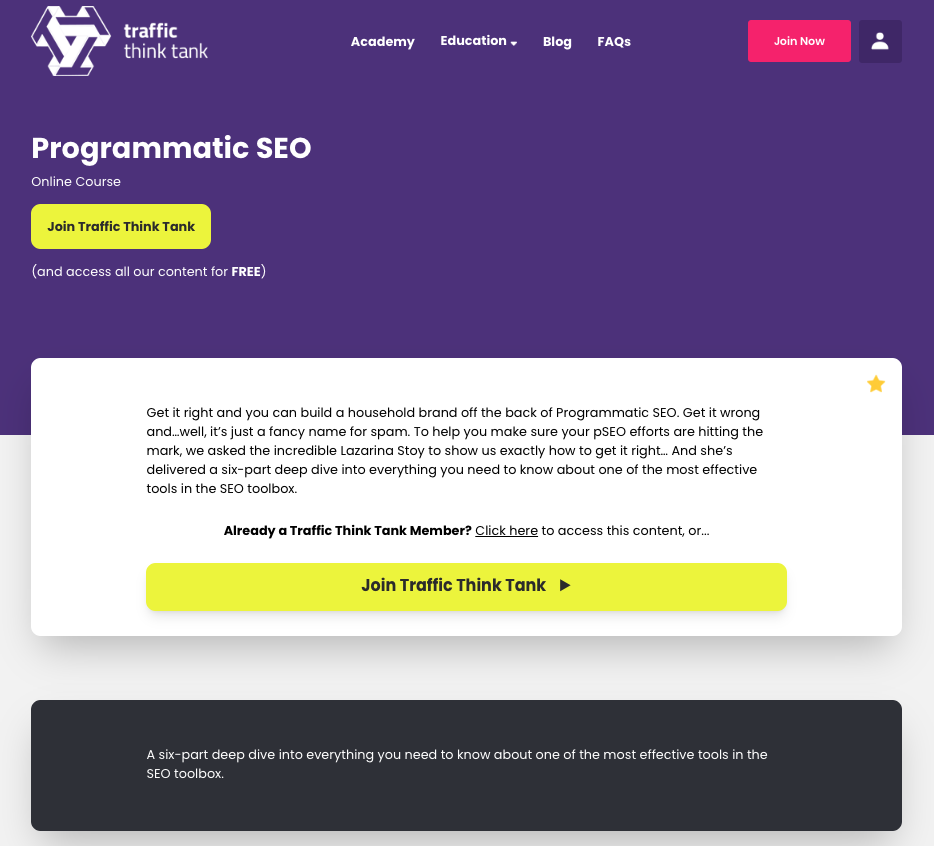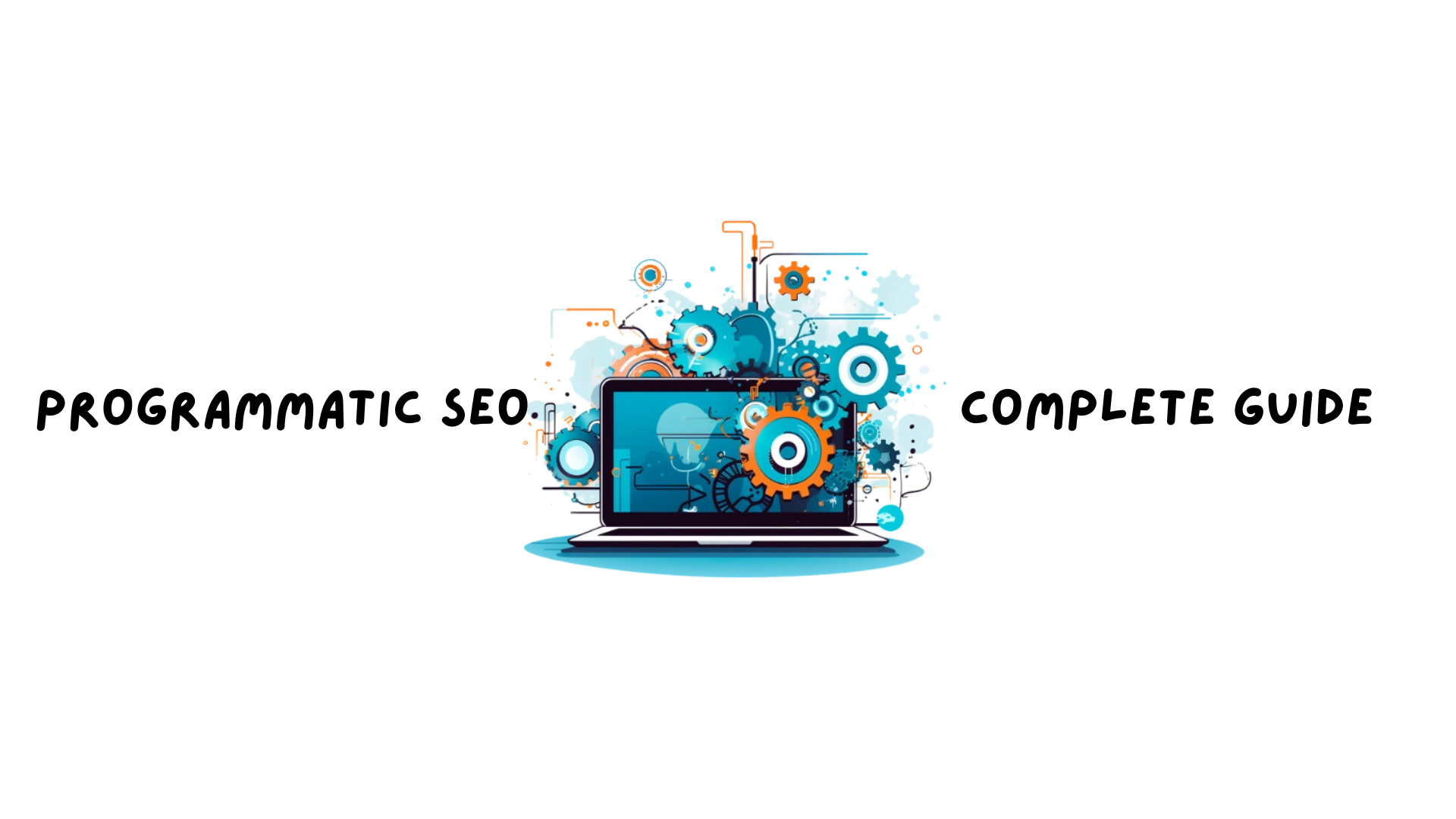With the rise of generative AI, programmatic SEO is becoming more and more misunderstood. In the following guide, I will:
- demystify the concept of programmatic SEO, including common misconceptions
- discuss examples of successful implementations of programmatic SEO
- go through a step-by-step guide on running programmatic SEO projects
This is a beginner-friendly guide, and while it will provide you with a complete understanding of the topic, it only touches upon the main concepts of this area of SEO. To get a more in-depth, specialised knowledge in this topic, I recommend you take my Programmatic SEO course on Traffic Think Tank.
What is programmatic SEO?
Programmatic SEO is an umbrella term that encompasses programmatic methods of improving organic search engine visibility. Notably, this includes things like:
- Automated, scalable content production methods
- Data-driven approach in opportunity identification and strategy
- Emphasis on systems design, not on individual pages or keywords
- Focus on page quality
The way this is most often done is through a combination of several components: a variety of content sources (including original research) are organized in a content database that is connected to a scalable page template. The publishing is done through a programmatic approach, pulling data from the database, and organising it into the page template via pre-defined rules. This then allows for programmatic page publishing and editing, leading to a more streamlined approach of on-page SEO as well.
Why does programmatic SEO exist?
Programmatic SEO is an approach that address the growing number of highly niche search intents via unique, high-quality pages. It aims to generate organic traffic to websites, while providing benefits to visitors (like ensuring all queries have a high-quality resource to address them, no matter how niche), which can also be very profitable, if executed to a high quality. It enables scale of efforts in several areas of SEO like content enhancements or internal linking, via the dynamic process implemented.
What are some misconceptions around programmatic SEO?
Programmatic SEO is often misunderstood. There are several prevailing misconceptions around it:
- It’s equivalent to spam. – It can be, but only when it’s done with the intention to spam. Not every spam page out there uses Programmatic SEO the same way that not every programmatically-built site section or site is automatically spam. If your pSEO build contains low-quality (thin or keyword-stuffed), plagiarised, or fully-automated content with no added originality, no value to the search landscape, or no value to the user experience, then it’s likely spam. Otherwise, you’re good.

- Programmatic SEO works for niche sites only – Any website can implement programmatic SEO or benefit from its principles. Big organizations, managing bigger broader websites often have an ease in properly executing programmatic SEO due to factors like access to budget for research and development, access to SEO expertise, and higher domain authority, so despite popular belief – they might actually benefit from pSEO principles even more.
- Programmatic SEO created low-quality, unoriginal content – With the appropriate research, coherent database, and well-organized template, which takes into consideration content SEO, technical SEO, and user experience, programmatic SEO projects can flourish.
Programmatic SEO websites share the same goals, characteristics, and concept approach. Practically, each programmatic SEO project has a robust, well-informed and organised database, a template, a scalable publishing and editing approach
What are examples of programmatic SEO?
- Forbes has incorporate programmatic SEO elements in their ‘person’ pages, including automated summaries of the person’s background and key sources of income, and sections with internal links, promoting discovery of Forbes lists, and other content
- Zapier‘s intergrations pages and software landing pages utilize principles of programmatic SEO, pulling data from their company databases of existing integrations and software, as well as using content patterns to populate the text elements
- Canva has created thousands of pages using their templates database, targeting queries like “create {type of creative}”, or “free {template example}”
- G2 uses programmatic SEO to populate their “best {industry} software” pages, where they utilise content patterns to generate reusable structures for FAQs and other text content, and their company database to populate listings of companies featured and to create custom visualizations
Other notable examples of programmatic SEO projects, executed well, are the websites of NomadList, and rome2rio, and the list-based articles and landing pages of Booking.com.

What are the benefits and limitations of programmatic SEO websites?
The benefits of programmatic SEO is that it enables:
- scalability in SEO enhancements and page publishing
- better conversion rates in highly targeted searches
- speed in editing and publishing
- brand domination in highly targeted searches
- when executed properly, can improve traffic and revenue
The challenges of programmatic SEO are:
- Implementing quality control to avoid thin pages, page duplication, and cannibalization
- Securing the investment, be it time, expertise, or for software costs
- Indexation and crawling can become an issue, if there are quality control issues or poor internal linking
- Duplication can become an issue, if there’s improper selection of keyword modifiers
There are also several broader concerns, related to programmatic SEO, such as environmental concerns, web quality issues, and spreading of misinformation, though these can be addressed if the principles of programmatic SEO are executed with care.
How to do programmatic SEO: Step-by-step guide
In this next section, I’ll take you through a rough overview of the steps needed in order to execute a programmatic SEO project. While holistic, this should give you an understanding of the complexity and organisation of a programmatic SEO campaign.
Choose your content niche
For a programmatic SEO project to be successful, regardless whether your building your entire website or a site section, the niche you choose should have:
- clearly defined goals, a reason the exist, and target audience
- a relatively low-competition, under-saturated niche, which provides a lot of opportunities for introducing original content to the web
- sufficient demand in terms of search terms and number of search variables
- enough data, or a clear pathway of sourcing original, high-quality data that can be condensed into a database
- the ability to break down search terms into variables
Let’s go over how to do identify niches by understanding the concept of programmatic SEO keyword structures, and specifically head terms and modifiers.
Head terms are broad, ambiguous keywords, describing the search intent your pages are aiming to address, while modifiers are variables that relate to the head term (or entity), typically different attributes that can be used as a descriptor to provide extra context of the term. Together, the two create programmatic SEO keywords. Some examples from companies using this approach are:
| Company | pSEO keyword (head term in bold) | Example title |
| Zapier | {software} + {software} integration | Google Docs + Google sheets Integration |
| Purina | can {animal} eat {food} | Can cats eat pork Can dogs eat mangos |
You can choose a single-variant strategy (the Zapier example), or multi-variant strategy (Purina example), depending on the complexity of the query, and the data you have.
Research and organise your keyword universe with keyword principles for programmatic SEO
Traditional keyword research focuses on metrics that are becoming obsolete, like search volume, keyword difficulty, competitive density. On the other hand, new approaches, like semantic keyword research, focus on concept and knowledge expansion and topical authority, also taking into account the user search behaviour and intent. When doing keyword research for programmatic SEO, focus on:
- selecting the right head terms by ensuring there is enough potential for variants and expanding the knowledge for the concept
- choosing terms with low competition and lower keyword volumes
- looking at SERP data, identifying opportunities to more clearly respond to the user query than the existing content
The difference between traditional keyword research and programmatic SEO keyword research is in the focus of your search. With programmatic keywords, your aim is to find templatable structures, with multiple variable possibilities and low competition.
Besides the semantics of keywords (entities and attributes), also consider the search volume and business purpose of the given attribute and its variables in a search engine landscape. For instance, both queries ‘influencers named Anna’ and ‘influencers with dogs’ might have negligible search volumes, but there is a business rationale of creating a landing page for the latter, as it might be useful for companies in the pet niche doing influencer marketing.
Note: As part of my my Traffic Think Tank course on programmatic SEO, I have a 40+ minute tutorial that goes very in-depth into keyword research for programmatic SEO, filled with examples like this one, and a step-by-step guide on exactly what to do.
A rough process to follow when doing keyword research for programmatic SEO is to:
- go through keywords for your head term, identify term attributes and jot down potential pSEO keyword with a single-variant or multi-variant strategy.
- create a map with all possible entity-attribute combinations related to your niche, adding all possible variables for each attribute
- Choose the ones that most closely relate to your goals, business, and site purpose
- Programmatically map all head terms and variables into your final target queries
- Validate the keywords through user research, keyword volume scoping (global and local), and SERP research
- Finalise your list of keywords, and prioritised topic clusters
Keyword research for programmatic SEO is all about finding head term and variable patterns with potential, and organising a coherent keyword universe of the main terms your pages with target.
Structure and populate your programmatic SEO database
When organising the database for your programmatic SEO project, consider the following core principles:
- Choose a hosting provider and platform that align with how you will later publish the pages and the CMS you are building on. Ensure the database also supports different data types (e.g. images, text, numbers, etc)
- Name different parameters descriptively, and use a consistent syntax. Adhere to best practices in database organization
- Consider data entry requirements and think about how you will enter data in the database, validate it, clean it, and so on. Select processes and systems that allow for automation and avoid manual entry errors.
- Build with SEO-first mindset, ensuring each entry to your database (typically for a page) aligns with best practices for titles, headings, content, images, etc. Automate the checks where possible.
- Plan with a systems mindset
Once you have all of this ready – you can start creating content. There are many ways to do this:
- sourcing content from experts
- using public datasets
- scraping or combining information from multiple sources
- generative AI – for creating content programmatically, I recommend Cuppa
Create your page template and content patterns (if any)
How much time and effort you put into your page layout is what will make or break your project’s success. Making a user-centric and search-friendly template is the goal.
Before doing anything related to your page template, conduct competitor research (if there are competitor pages out there in your niche or others like it) and pinpoint the page templates elements of successful competitors, and create a custom must-have list for your site type.
A good template will be user-friendly, well structured (both from a UX, web dev and SEO standpoint, including technical and on-page), and data-driven. Consider aspects like loading speed, mobile responsiveness, navigation and links, and structured data implementation.
Don’t neglect the need for continuous improvement, as this will be vital for maintaining the success of your project later on. Build with a ‘kaizen’ principle in mind, as successful programmatic SEO websites always end up becoming the target of big companies, or new SERP features.
Content patterns are templatable word structures (layouts) that can be replicated across multiple pages, without compromising content quality. They can be as short as a heading or title, or longer (e.g. paragraph form, or a structure for answering a question). This technique is often also used in structuring entire content types, like listicle pages. Using content patterns has many benefits for users, for content quality, and for scalability, which is why many companies use them.
For example:
- Glassdoor populates its FAQ section from its company ratings database using a content pattern, allowing for a similar and familiar experience for users, and opportunities for internal links which can improve page discovery
- Amazon populates several elements on the product pages with their product listings data, notably the product comparison tables, which improves the user experience on these pages and adds additional value
Publish your pages using a no-code or custom solution
You can use a variety of different methods here, depending on your site structure and your coding skills, as well as the requirements you have for your programmatic SEO build (e.g. whether you are publishing a multilingual website, how many pages you have, what level of security you have, whether you will be accepting payments, how you’ve structured the site architecture and content, and so on.
You can use a no-code approach for page publishing via platforms like Zapier, or with a WordPress Plug in like WP All Import, or choose a solution that’s integrated with your CMS provider natively like the dynamic collections (content management systems, CSM) function of Wix, or Webflow.
You might also choose a more sophisticated approach like a headless CMS, static site generator, or a custom application.
It’s good to have a publishing frequency and a content calendar in place before you start publishing pages. Also, you will likely be interested in monitoring indexation rates, so ensure you have analytics and reporting in place before you launch your website.
Don’t forget to implement SEO enhancements for your programmatic SEO pages, pre- and post- launch! Think of things like sitemaps, structured data, image enhancements, cannibalization and duplication checks.
Bottom line? Programmatic SEO is helpful, only if done right
I’ve had the pleasure of meeting three people I consider have fascinating experience with programmatic SEO, as well as following the journey of many others. Combined with my own experience in the field, I can say this:
Programmatic SEO is not just spam, and is not just pumping out content programmatically. It is a mindset of thinking about organic visibility enhancements that incorporates what’s best for the user, like having niche searches addressed, and best for the business, like having a scalable way to improve traffic and revenue via the website. There is a reason why there are so many successful examples of programmatic SEO approaches being used in some of the most successful sites out there, and even by Google when creating their own SERP features.
I understand there is another side of this debate, and I’m aware of presenting positive examples in this post. While there are many negative examples of ‘programmatic SEO websites’ there, under the hood they often turned out to be simply websites built programmatically, but not incorporating many of the principles and best practices that experts in this niche swear by.
Finally, I leave you with a list of people to follow to learn more on this topic:
- Ian Nuttall – Founder of PracticalProgrammatic.com, URL Monitor, Niche Site Metrics, and more
- Deepak Ness – Founder of UntalkedSEO.com
